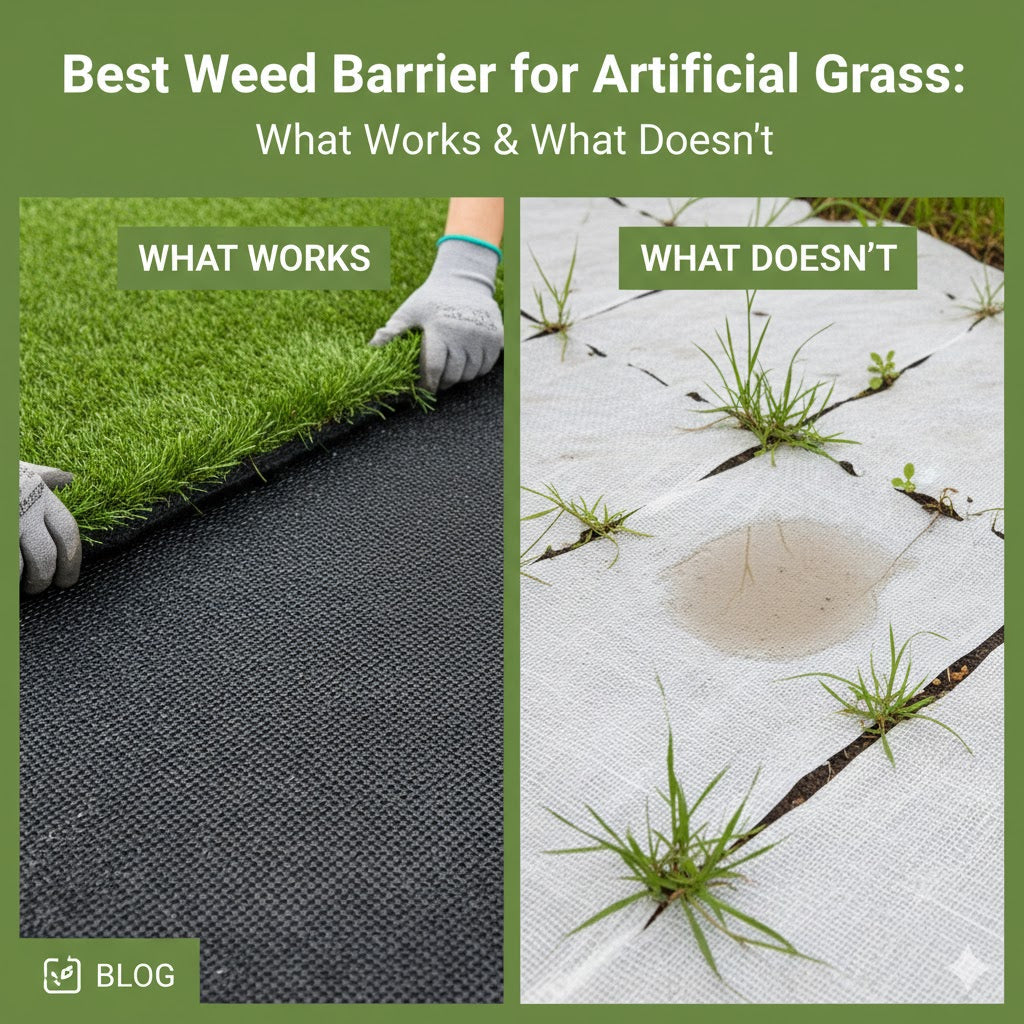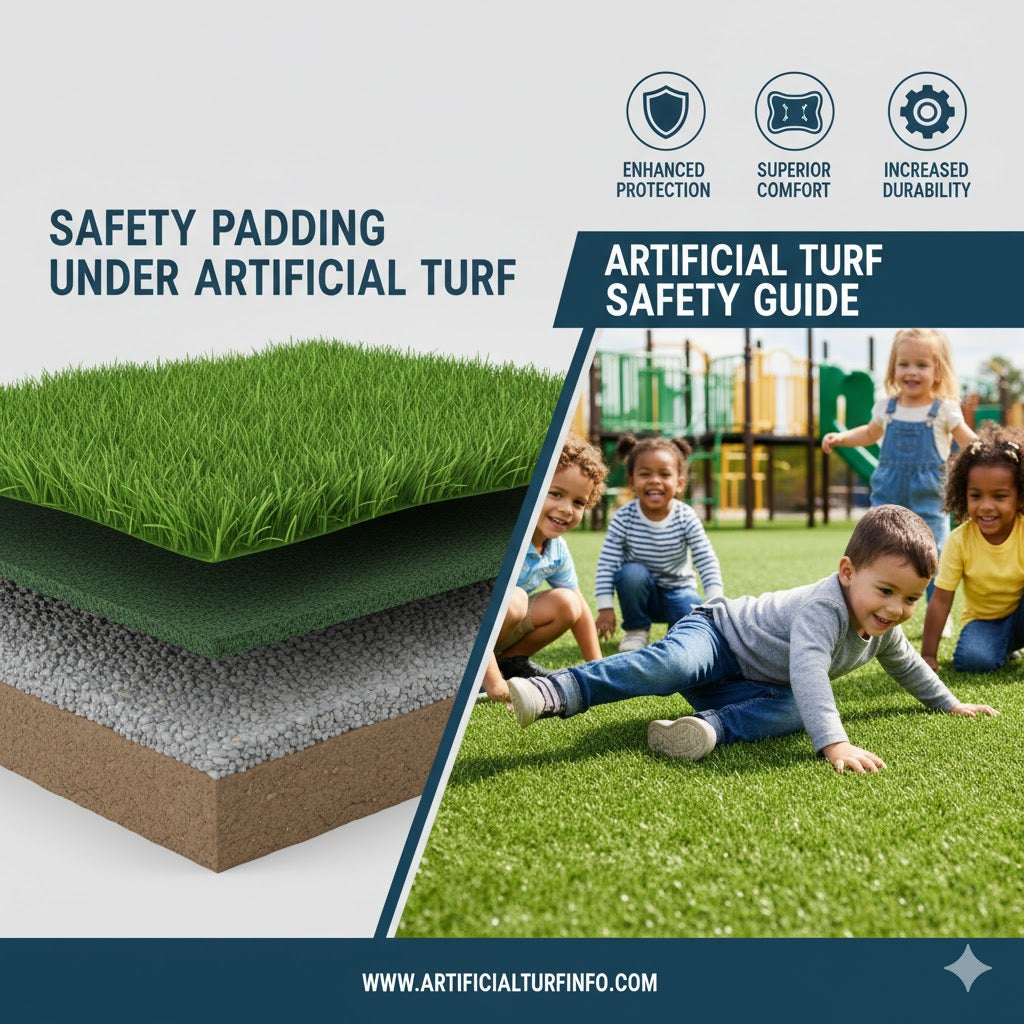A weed barrier for artificial grass is one of the most important parts of a clean, low-maintenance lawn. Weeds can still grow even under fake grass, and once they appear, they’re hard to remove. You might think artificial turf means zero weeds, but without the right barrier, tiny roots can sneak through seams, drainage holes, or the edges of your lawn. Over time, they spoil the neat look of your turf and make it harder to keep clean. Many homeowners search for the best weed barrier for artificial grass or wonder do you need a weed barrier under artificial turf to keep their synthetic lawns weed-free.
Using a good barrier stops most of that trouble before it starts. It blocks sunlight from reaching weed seeds, helps water drain through properly, and keeps your base layers separate and stable. But not every material works well. Some fabrics tear too easily, hold water, or fail to stop tough weeds.
Why Weeds Can Still Grow in Synthetic Turf
Even with a weed barrier for artificial grass, some weeds can still find their way through. It might sound strange, but it happens more often than most people expect. The barrier blocks a lot, but not everything.
Weeds can grow from wind-blown seeds that land on top of the turf. Dust and organic matter build up over time, making a thin layer where seeds can sprout. Small cracks, seams, or drainage holes also give weeds just enough space to push through.
Another reason is the edges of the turf. If they aren’t sealed or trimmed well, weeds can crawl in from the sides. Some aggressive types, like Bermuda grass or nutgrass, can grow under the edges and break through even thick fabric.
Moisture can make the problem worse. When water doesn’t drain right, weed roots grow faster in the damp soil under the turf. That’s why proper drainage and a strong barrier layer matter just as much as weed control. To fully prevent these issues, using a non-woven geotextile fabric for artificial grass or a landscape fabric for turf installation can make a huge difference in drainage and weed control.
What Makes a “Best” Weed Barrier for Artificial Grass
The best weed barrier for artificial grass does more than just block weeds. It helps your whole turf system last longer and look better. A strong barrier supports the base, drains water, and keeps your lawn low-maintenance for years.
Here are the key things that make a barrier worth using:
1. Good Drainage
Water must pass through the fabric quickly. If it doesn’t, puddles can form and weaken your base. Look for a fabric that drains easily but still blocks light so weeds can’t grow underneath.
2. Strength and Durability
The barrier sits under rock and turf, so it faces pressure and movement. A weak fabric can tear during installation. Choose a heavy non-woven or geotextile fabric that won’t rip when compacted or walked on.

3. UV Resistance
Sunlight breaks down weak materials over time, especially near turf edges. A UV-resistant barrier lasts longer and keeps its shape, even in hot weather.
4. Breathability
Your turf needs to “breathe.” A good barrier lets air and water move freely. This prevents trapped moisture, which can cause smells and weaken your base.
5. Compatibility with the Installation
The best barrier works well with your synthetic turf installation. It should fit tightly under the turf, lay flat, and not shift when stapled or nailed.
6. Longevity and Value
Cheap fabric might save you money now but cost more later when weeds return. A quality barrier may cost a little more but lasts many years and protects your investment.
What Doesn’t Work and Common Mistakes
Even the best weed barrier for artificial grass won’t help if it’s used the wrong way. Many people make simple mistakes during installation that cause weeds to return faster than expected.
Using the Wrong Fabric
One of the biggest mistakes is using cheap garden fabric. These thin layers tear easily and don’t handle heavy turf or traffic. Some aren’t made for outdoor use and break down quickly in the sun. Plastic sheets are even worse — they block water, create puddles, and can make your lawn smell bad.
Poor Drainage
A barrier that doesn’t allow proper drainage traps moisture under the turf. That damp layer becomes the perfect home for weed roots and mold. Always pick a fabric that drains water fast and doesn’t clog easily.
Not Securing the Edges
Weeds often sneak in from the edges of the lawn. If the fabric isn’t pinned down tightly or the turf edges aren’t sealed, weeds can crawl in from the sides. Overlap each section by at least six inches and staple or nail it down firmly.
Skipping Base Prep
Laying the barrier over old grass or roots is a bad idea. Weeds can grow right through thin layers. Always clear the area, remove roots, and compact the soil before putting down the barrier and base materials.
Expecting Zero Weeds Forever
No barrier can stop 100% of weed growth. Some tiny seeds land on top of the turf and sprout in the infill. Regular cleaning and brushing help prevent that. The barrier mainly stops weeds from below, not from above.
How and Where to Install Weed Barrier in a Synthetic Turf System
Installing a weed barrier for artificial grass the right way is just as important as choosing the right one. A good fabric can fail if it’s not placed or secured correctly. Here’s how to do it right from the start.
Step 1: Clear the Area
Remove all old grass, roots, and debris. Pull out deep weeds completely so they don’t grow back later. If you have strong weeds like Bermuda grass, treat them before installing the barrier. A clean, level surface gives the best result.
Step 2: Prepare the Base
After clearing the soil, add a base material like crushed rock, class II road base, or decomposed granite. Spread it evenly and compact it well. This helps drainage and creates a solid, stable base for your synthetic turf.
Step 3: Place the Barrier
Lay the fabric flat over the base. Keep it tight and wrinkle-free. Overlap the edges by six to twelve inches so weeds can’t sneak through the gaps. Use landscape staples or nails every two to three feet to keep it in place.
Step 4: Focus on Edges
Weeds often enter from the edges of the turf. Seal or trim edges tightly and press the fabric down firmly. Use edging stones or borders if needed to stop roots and grass from spreading under the turf.
Step 5: Check Drainage
Before installing the turf, pour some water over the barrier to test drainage. The water should soak through quickly without puddling. If it collects, you may need to adjust the slope or replace a blocked section.
Step 6: Install the Turf
Lay your synthetic grass over the barrier. Trim it to fit and secure the seams properly. Brush in your infill material, such as ZeoFill or silica sand, to help the turf stand upright and allow water to flow through.
Step 7: Inspect Regularly
After installation, check your turf a few times a year. Look for lifted edges or areas where weeds try to appear. Small fixes early prevent bigger problems later.

Maintenance and Long-Term Weed Management
Even with a strong weed barrier for artificial grass, you still need a little care to keep your lawn clean. A barrier stops most weeds from growing up through the turf, but some can still appear from above. Wind can blow weed seeds onto your lawn, and they can grow in the dust and debris that build up over time.
Keep It Clean
Sweep or brush your turf every few weeks. A stiff broom or power brush works well. This removes leaves, soil, and small seeds that might start to grow. Cleaning also keeps the turf fibers standing upright and helps the surface drain better.
Watch the Edges
Weeds often start around the edges where the turf meets walkways, fences, or flower beds. Check those areas often. If you see a small plant, pull it out before it spreads. You can also apply a weed control product or a natural weed killer spray along the edges once or twice a year if needed.
Keep Drainage Open
Over time, dust and sand can block drainage holes in the turf. Spray water through the turf every few months to flush out dirt. Good drainage stops weed roots from finding a wet, dark space to grow.
Spot Fix Small Problems
If you see a tear or lifted section, fix it quickly. A gap or loose edge lets light and air reach the soil, which helps weeds grow. Press the turf down, re-staple, or glue it if needed.
Plan for the Long Term
A quality barrier can last ten years or more, but it won’t last forever. If you replace your turf in the future, replace the barrier too. This ensures strong weed prevention and healthy drainage for many more years.
FAQ
1. Do I really need a weed barrier under artificial grass?
Yes, a weed barrier for artificial grass prevents unwanted plants from growing up through your turf and extends its lifespan
2. What’s the best fabric to prevent weeds under turf?
A non-woven geotextile fabric or UV-resistant landscape fabric provides excellent strength and drainage.
3. How long does a weed barrier last under synthetic grass?
Most synthetic turf weed barriers last 10 years or more with proper installation.
4. Can weeds still grow through artificial grass?
Only rarely — mostly from seeds landing on top of the turf. Regular brushing and cleaning prevent that.
Conclusion
A weed barrier for artificial grass is one of the most important parts of a strong and lasting turf system. It keeps weeds from growing up through your lawn, supports proper drainage, and helps your turf look clean year after year.
The best barriers are strong, breathable, and made to handle pressure and water flow. Non-woven or geotextile fabrics work best for most homes. They stop weed growth without blocking water or air.
Remember, even the best barrier needs a good base and careful installation. Clear the area, compact the soil, overlap the seams, and secure the edges well. Regular cleaning and edge checks will keep your synthetic lawn in great shape.



Leave a comment
This site is protected by hCaptcha and the hCaptcha Privacy Policy and Terms of Service apply.